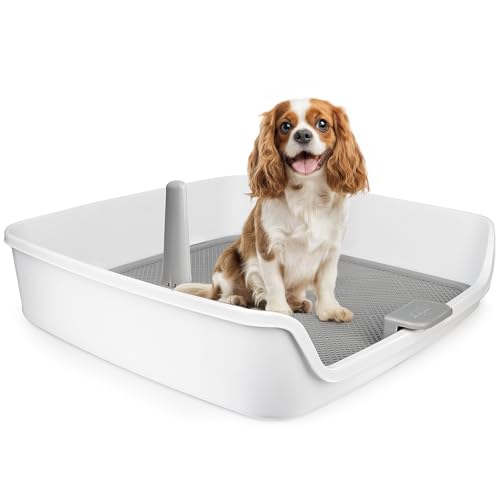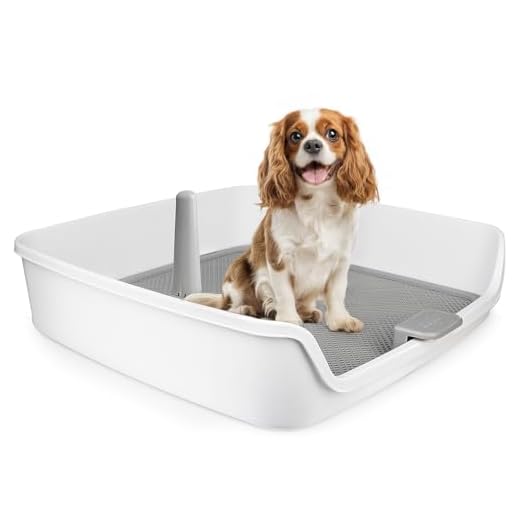




Begin by selecting a designated area within your home that’s quiet and easily accessible. Using pee pads or a suitable tray helps in creating a specific spot for your pet. Consistency is key; ensure that this area remains the same throughout the learning process.
Introduce this designated space to your furry friend by guiding them to it regularly, especially after meals or playtime. Each time they show interest in the area, reward them with treats or praise. Positive reinforcement encourages them to associate this spot with relief.
Monitor your companion’s behaviour closely, especially during the early days. Signs such as sniffing or circling can indicate the need for a bathroom break. When you notice these signals, gently direct them to the designated area. If they succeed, celebrate their accomplishment with enthusiasm.
Patience is vital; accidents may happen. If your companion misses the mark, avoid punishment. Instead, clean up without fuss and continue guiding them towards the right spot. Over time, with encouragement and practice, they will learn to seek out this area instinctively.
As your furry friend becomes more familiar with the routine, gradually reduce the frequency of guidance. Eventually, they will likely start using the designated space independently. Regularly reinforce the behaviour with praise to maintain their confidence.
Techniques for Encouraging Indoor Elimination
Establish a designated area for waste. A specific spot within your living space helps create a routine. Use a tray filled with absorbent materials that mimic a traditional outdoor environment. This familiarity can make the transition smoother.
Introduce the area gradually. Allow your canine companion to explore the new setup without pressure. Use treats or praise when they show interest in the designated spot. Positive reinforcement builds a connection between the area and favourable behaviour.
Maintain a consistent schedule for bringing your pet to the designated area. Regular intervals, especially after meals or playtime, reinforce the idea of this being the appropriate location for relieving themselves.
Monitor hydration levels. Ensuring your pet has access to fresh water can lead to more frequent potty breaks, which can be beneficial for forming a routine. Keeping an eye on their behaviour can also help in identifying when they need to go.
Be patient and observant. Accidents may happen, but it’s essential to avoid punishment. Instead, clean up any messes thoroughly to eliminate any residual scent that might attract them back to the wrong spot.
Gradually reduce the size of the designated area as they become more accustomed to it. This technique encourages them to associate the smaller space with elimination, making it easier to manage over time.
Stay consistent with your approach. Changes in routine can confuse them, so maintaining a steady method helps reinforce learning. Over time, they will grasp the concept of where to go, making life easier for both of you.
Selecting the Right Litter Box for Your Canine Companion
Opt for a spacious option that allows movement without restrictions. A larger container provides comfort, especially for bigger breeds. Consider height as well; it should be low enough for easy entry yet tall enough to prevent messes.
Material matters. Plastic is lightweight and easy to clean, while metal can endure wear and tear better. Choose a non-toxic variety to ensure safety for your furry friend.
Look for models with high sides to minimise spills and accidents. Some designs include a removable top, making it easier to access and maintain. Incorporating a cover can also help contain odours.
Evaluate the design features. Certain containers come with disposable liners or built-in waste management systems, which can simplify cleanup. Ensure the base provides stability, preventing tipping during use.
Test the setup. Observe how your pet interacts with the chosen container. If they hesitate or seem uncomfortable, it may be necessary to try a different style or size. Adjustments may be needed based on their behaviour.
Take into account the location as well. The chosen spot should be quiet and accessible, away from high-traffic areas. This can also influence the type of container you select, as some designs are more discreet than others.
Choosing the Best Litter Material for Your Dog
Opt for clumping clay or biodegradable options for optimal results. Clumping clay offers simplicity in maintenance, while biodegradable materials, such as corn or paper, are eco-friendly.
- Clumping Clay: Highly absorbent, this type forms solid clumps when wet, making cleanup straightforward. Look for unscented varieties to avoid overwhelming your canine.
- Bamboo: This sustainable choice is both absorbent and biodegradable. It’s gentle on paws and offers a natural alternative for pet owners concerned about chemicals.
- Corn-based: Made from natural corn, this litter is biodegradable and clumps well. It typically has a mild scent, which can be appealing.
- Paper pellets: Recycled paper litter is soft, making it comfortable for sensitive paws. It absorbs moisture effectively and is dust-free, reducing respiratory issues.
Consider your canine’s preferences as well. Some may prefer a softer texture, while others might not mind a coarser material. Observing their reactions can guide your selection.
Always keep an eye on how your pet interacts with the chosen material. If they show signs of discomfort or reluctance, it may be time to switch. Also, maintaining cleanliness is key; regular changes will prevent unpleasant odours and ensure a pleasant environment.
If you’re interested in enhancing your pet’s nutrition alongside this transition, check out the best salmon and potato dog wet food. A balanced diet contributes to overall well-being, making the adjustment period smoother.
Introducing Your Canine Companion to the Litter Tray
Begin by placing the tray in a quiet, accessible location where your pet feels comfortable. Avoid areas with heavy foot traffic or loud noises, as this can deter them from approaching the new setup.
Next, encourage exploration. Allow your pet to sniff and investigate the tray without pressure. Use treats to create positive associations. When they get near the tray, reward them immediately. This builds a connection between the tray and a pleasant experience.
Consistency is key. Encourage your furry friend to approach the tray at regular intervals, especially after meals or playtime. Establishing a routine helps them understand when to engage with the tray.
Observe their behaviour closely. If they show signs of confusion or reluctance, try to identify the cause. Perhaps the tray is too high or the litter material is off-putting. Adjust as necessary to ensure a comfortable experience.
| Tip | Description |
|---|---|
| Location | Choose a quiet, low-traffic area for the tray. |
| Exploration | Allow sniffing and investigating without pressure. |
| Positive Reinforcement | Use treats to reward proximity to the tray. |
| Routine | Encourage visits after meals or playtime. |
| Observation | Watch for signs of confusion or discomfort. |
Patience is paramount. Each companion adjusts at their own pace, so be encouraging and understanding. With time, they will likely embrace the tray as their designated spot.
Establishing a Routine for Litter Box Training
Set specific times for potty breaks. Consistency is key; take your furry friend to the chosen spot every morning after meals and before bedtime. This helps create a natural rhythm, making it easier for them to understand when it’s time to relieve themselves.
Incorporate Positive Reinforcement
Each time a successful visit occurs, reward with praise or a small treat. This positive reinforcement encourages repeat behaviour, reinforcing the idea that they’ve done something commendable.
Track Progress
Keep a diary of your companion’s habits. Note the times they go and any accidents. This tracking allows you to adjust the routine if needed, ensuring their needs are met effectively. Over time, patterns will emerge, helping to refine the schedule.
Patience is vital. Every pet learns at their own pace, so celebrate small victories along the way. Consistent routines lead to successful outcomes, making the experience enjoyable for both of you.
Common Challenges and Solutions in Litter Box Training
One frequent issue is reluctance or refusal to approach the designated area. To combat this, try placing treats or favourite toys near the entry. Gradually move them closer to the spot until curiosity takes over. Positive reinforcement is key; every time there’s an attempt to engage with the space, reward generously.
Accidents Outside the Designated Area
Accidents can happen, even with consistent efforts. If you find messes away from the chosen spot, avoid scolding. Instead, clean up thoroughly to remove any lingering odours that might attract attention again. Consider using enzymatic cleaners to break down the scent completely. Establishing a stronger routine can also help; frequent bathroom breaks can reduce incidents, especially after meals or playtime.
Choosing the Right Location
Placement of the area can significantly impact success. Avoid high-traffic zones or noisy environments that may deter exploration. Look for a quiet, private space where the animal feels safe. If it’s too far from regular activity areas, they may hesitate to go. Experiment with locations until you find one that encourages regular visits. Regular monitoring will help determine the most effective spot.






